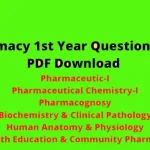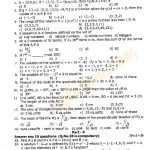The article provides detailed questions and answers for D Pharmacy previous year exams. It covers various subjects, including pharmaceutical chemistry, pharmacology, and pharmacognosy. Each subject contains at least 20 questions with answers, following a simple and easy-to-understand structure. The goal is to help students in their preparation for D Pharmacy exams by giving them insight into the types of questions asked.
Pharmaceutical Chemistry
Question: What is the principle of acid-base titration?
Answer: Acid-base titration is based on the neutralization reaction between an acid and a base, using an indicator to detect the endpoint.
Question: Define the term ‘buffer solution.’
Answer: A buffer solution resists changes in pH when small amounts of an acid or base are added to it.
[save_as_pdf_pdfcrowd]
Question: What is the role of a catalyst in a chemical reaction?
Answer: A catalyst speeds up a chemical reaction without being consumed in the process.
Question: Explain the term ‘molarity.’
Answer: Molarity is the concentration of a solution expressed as moles of solute per liter of solution.
Question: What is a strong acid? Give an example.
Answer: A strong acid completely dissociates in water. Example: Hydrochloric acid (HCl).
Question: What are isotopes?
Answer: Isotopes are atoms of the same element with different numbers of neutrons but the same number of protons.
Question: Define oxidation and reduction.
Answer: Oxidation is the loss of electrons, while reduction is the gain of electrons.
Question: What is the significance of the pH scale?
Answer: The pH scale measures the acidity or basicity of a solution, with values ranging from 0 to 14.
Question: What are the differences between ionic and covalent bonds?
Answer: Ionic bonds involve the transfer of electrons, while covalent bonds involve the sharing of electrons between atoms.
Question: Explain the term ‘valency.’
Answer: Valency is the combining capacity of an element, determined by the number of electrons in its outer shell.
Question: What is Avogadro’s number?
Answer: Avogadro’s number is 6.022 × 10²³, representing the number of atoms or molecules in one mole of a substance.
Question: Define electrolysis.
Answer: Electrolysis is the process of using an electric current to drive a non-spontaneous chemical reaction.
Question: What is the difference between an exothermic and an endothermic reaction?
Answer: Exothermic reactions release heat, while endothermic reactions absorb heat.
Question: What is meant by ‘rate of reaction’?
Answer: The rate of reaction is the speed at which a chemical reaction proceeds.
Question: Explain the concept of dynamic equilibrium.
Answer: Dynamic equilibrium occurs when the rate of the forward reaction equals the rate of the reverse reaction in a reversible process.
Question: What are electrolytes?
Answer: Electrolytes are substances that dissociate into ions in solution and conduct electricity.
Question: Define the term ‘allotropy.’
Answer: Allotropy refers to the existence of two or more different physical forms of a chemical element.
Question: What is a reducing agent?
Answer: A reducing agent donates electrons in a redox reaction, thereby reducing another substance.
Question: What is meant by solubility?
Answer: Solubility is the ability of a solute to dissolve in a solvent at a specific temperature.
Pharmacology
Question: Define pharmacokinetics.
Answer: Pharmacokinetics is the study of the movement of drugs within the body, including absorption, distribution, metabolism, and excretion.
Question: What is the difference between an agonist and an antagonist?
Answer: An agonist activates a receptor to produce a biological response, while an antagonist blocks or dampens the response.
Question: What is the therapeutic index?
Answer: The therapeutic index is the ratio between the toxic dose and the therapeutic dose of a drug, indicating its safety margin.
Question: What are adverse drug reactions?
Answer: Adverse drug reactions are unintended and harmful effects caused by the administration of drugs.
Question: Explain the concept of bioavailability.
Answer: Bioavailability is the proportion of a drug that enters the circulation and is available to produce an active effect.
Question: What is the first-pass effect?
Answer: The first-pass effect is the metabolism of a drug in the liver after oral administration, reducing the amount of active drug reaching the systemic circulation.
Question: What is the significance of drug half-life?
Answer: Drug half-life is the time required for the concentration of the drug in the body to reduce by half.
Question: Define therapeutic drug monitoring.
Answer: Therapeutic drug monitoring involves measuring drug levels in the bloodstream to ensure optimal therapeutic concentration and avoid toxicity.
Question: What is pharmacodynamics?
Answer: Pharmacodynamics is the study of the physiological and biochemical effects of drugs on the body.
Question: What is meant by drug tolerance?
Answer: Drug tolerance is the diminished response to a drug after repeated use, requiring higher doses to achieve the same effect.
Question: What are enzyme inhibitors?
Answer: Enzyme inhibitors are substances that reduce or block the activity of enzymes, affecting metabolic processes.
Question: Define the term ‘placebo.’
Answer: A placebo is a substance with no therapeutic effect, often used as a control in clinical trials.
Question: What are the routes of drug administration?
Answer: Drugs can be administered orally, intravenously, intramuscularly, subcutaneously, or through inhalation, transdermal, and other routes.
Question: What is the blood-brain barrier?
Answer: The blood-brain barrier is a protective barrier that prevents certain substances from entering the brain from the bloodstream.
Question: What is anaphylaxis?
Answer: Anaphylaxis is a severe, potentially life-threatening allergic reaction that occurs rapidly after exposure to an allergen.
Question: What is the role of the liver in drug metabolism?
Answer: The liver metabolizes drugs, converting them into active or inactive forms to be excreted from the body.
Question: What is a prodrug?
Answer: A prodrug is an inactive compound that is metabolized into an active drug within the body.
Question: Define the term ‘idiosyncratic reaction.’
Answer: An idiosyncratic reaction is an unusual or unexpected response to a drug that is not related to dose or duration of use.
Question: What are the factors affecting drug absorption?
Answer: Factors affecting drug absorption include the drug’s formulation, route of administration, solubility, and the presence of food or other drugs.
Pharmacognosy
Question: What is pharmacognosy?
Answer: Pharmacognosy is the study of natural products, including plants, animals, and minerals, used in medicine.
Question: What are alkaloids?
Answer: Alkaloids are naturally occurring organic compounds, usually containing nitrogen, with significant pharmacological effects.
Question: What is the significance of glycosides in medicine?
Answer: Glycosides are compounds that release sugars and other therapeutic agents, often used in cardiac and anti-inflammatory drugs.
Question: What are tannins?
Answer: Tannins are astringent compounds found in plants that have antimicrobial and anti-inflammatory properties.
Question: What is the role of volatile oils in medicinal plants?
Answer: Volatile oils, also known as essential oils, are responsible for the fragrance and therapeutic properties of many medicinal plants.
Question: Define the term ‘flavonoids.’
Answer: Flavonoids are plant-based compounds known for their antioxidant, anti-inflammatory, and immune-modulating effects.
Question: What is resin?
Answer: Resin is a sticky substance secreted by plants, often used in traditional medicine for its antimicrobial and wound-healing properties.
Question: What is the difference between organized and unorganized drugs in pharmacognosy?
Answer: Organized drugs are those with a cellular structure, like leaves and seeds, while unorganized drugs include extracts and resins.
Question: What are steroids, and where are they found?
Answer: Steroids are organic compounds found in plants and animals, used in medicine for their anti-inflammatory and hormonal effects.
Question: What are the medicinal uses of cinnamon?
Answer: Cinnamon is used for its antimicrobial, anti-inflammatory, and antioxidant properties, often in digestive and respiratory disorders.
Question: Explain the term ‘phytochemistry.’
Answer: Phytochemistry is the study of the chemical compounds produced by plants, particularly those with medicinal properties.
Question: What are saponins?
Answer: Saponins are plant compounds that create foam when mixed with water and have cholesterol-lowering and immune-boosting properties.
Question: What are fixed oils?
Answer: Fixed oils are non-volatile oils extracted from plants that are used in medicine and cosmetics.
Question: Define terpenoids.
Answer: Terpenoids are a large class of organic chemicals derived from terpenes, with medicinal uses such as anti-inflammatory and antimicrobial effects.
Question: What are the sources of caffeine?
Answer: Caffeine is obtained from coffee beans, tea leaves, and cocoa, known for its stimulant properties.
Question: What is the role of mucilage in plants?
Answer: Mucilage is a gelatinous substance produced by plants that is used medicinally to soothe irritated tissues.
Question: What are coumarins?
Answer: Coumarins are naturally occurring compounds found in many plants, known for their anticoagulant and anti-inflammatory effects.
Question: What are medicinal gums?
Answer: Medicinal gums are water-soluble substances exuded by plants, used as binding agents and to treat digestive issues.
Question: What is the significance of quinine?
Answer: Quinine is an alkaloid derived from the bark of the cinchona tree, historically used to treat malaria
[save_as_pdf_pdfcrowd]
More Links:
D Pharmacy 1st Year Question Paper 2018
D Pharmacy 1st Year Question Paper Solved Pdf 2022
Latest Posts
- Step-by-step guide to download and apply for jee mains admit card 202
- Comprehensive 2025 government holidays and recruitment details for job seekers
- JEE Mains Admit Card 2025: Your Step-by-Step Guide to Downloading the Hall Ticket
- Everything You Need to Know About 2025 Government Holidays Recruitment
- Comprehensive Guide to rrb d group recruitment 2025 – Eligibility, Vacancies, and Application
- Detailed guide to nps trust recruitment 2025 vacancies, eligibility and apply process
- Comprehensive guide to hpcl recruitment 2025 notification, vacancies, and application process
- ignou bed admission 2025 complete recruitment guide with eligibility and process
- Comprehensive Guide to Indian Army Agniveer Recruitment 2025 Notification and Jobs
- Everything You Must Know About CBSE Board Exams 2025 Changes & New Rules





